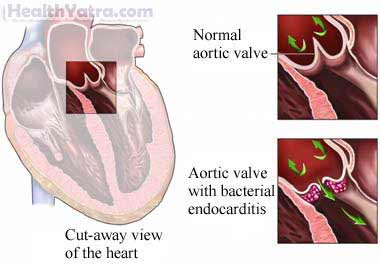Definition
The endocardium is a thin layer of membrane (tissue) that covers the inner surface of the heart. Bacterial endocarditis is an infection of this membrane. Infection occurs when bacteria attach to the membrane and grow.
The infection is most common when the heart or valves have already been damaged. It can permanently damage the heart valves. This can lead to serious health problems, such as congestive heart failure. Bacterial endocarditis can be life-threatening.

The infection can also cause growths on the valves or other areas of the heart. Pieces of these growths can break off and travel to other parts of the body. This can cause serious complications.
Causes
Bacteria can travel to the heart through the blood. It can enter the blood from an infection somewhere else in the body. It can also enter during an activity that causes breaks in the skin or tissues. This activity can be dental work, surgery, or IV drug use. Only certain bacteria cause this infection. The most common are:
- Streptococci
- Staphylococci
- Enterococci
The bacteria may be able to attach to the endocardium. Some heart conditions can increase the chance of infections. These conditions may cause blood flow to be blocked or to pool. This provides a place for the bacteria to build up.
Risk Factors
The following conditions put you at greater risk during certain procedures:
- Heart valve scarring, due to rheumatic fever or other conditions
- Artificial heart valve
- Heart defect present at birth (congenital)
- Cardiomyopathy
- Prior episode of endocarditis
- Mitral valve prolapse, with significant regurgitation (abnormal backflow of blood)
The conditions listed above increase your risk of the infection with certain activities such as:
- IV drug use; risk is very high when needles are shared
- Any dental procedure, even cleanings
- Removal of tonsils or adenoids, and other procedures involving the ears, nose, and throat
- Bronchoscopy (viewing the airways though a thin, lighted tube)
- Surgery on the gastrointestinal or urinary tracks, including the gallbladder and prostate
Symptoms
Symptoms vary from mild to severe, depending on:
- The bacteria causing the infection
- The amount of bacteria in the blood
- The degree of structural heart defects
- Your body’s ability to fight infection
- Your overall health
Symptoms that can begin within two weeks of the bacteria entering the bloodstream include:
- Fever
- Chills
- Fatigue
- Weakness
- Discomfort
- Unexplained weight loss
- Poor appetite
- Muscle aches
- Joint pain
- Coughing
- Shortness of breath
- Little red dots on the skin, inside the mouth, and/or under the nails
- Bumps on the fingers and toes
Note: The first symptom may be caused by a piece of the infected heart growth breaking off. This can include a stroke or other complication to another organ.
Diagnosis
The doctor will ask about your symptoms and medical history and perform a physical exam. The doctor will listen to your heart for a murmur.
Tests may include:
- Your doctor may need to check your blood. This can be done through:
- Blood cultures
- Blood tests
- Your doctor may need images of your heart and how it functions. This can be done through:
- computed tomography (CT) scan
- Electrocardiogram (ECG, EKG)
- Echocardiogram
- Transesophageal echocardiogram
Treatment
Treatment will focus on getting rid of the infection in the blood and heart.
Medication
Antibiotics are given through an IV into a vein. You must be admitted to the hospital for this treatment. This therapy may last for 4-6 weeks.
Surgery
The antibiotics may not remove the bacteria. The infection may also return. In this case, surgery may be needed.
Surgery may also be needed if there was damage done to the heart or valves from the infection.
Prevention
The best way to prevent endocarditis is to avoid the use of illegal IV drugs. Certain heart conditions may increase your risk. Talk to your doctor to find out whether you are at increased risk for this condition. The American Heart Association (AHA) recommends that people at very high risk take antibiotics before and after certain dental and medical procedures.
You should also:
- Tell your dentist and doctors if you have any heart conditions.
- Maintain good oral hygiene:
- Brush your teeth twice every day.
- Floss every day.
- Visit your dentist for a cleaning at least every six months.
- See your dentist if dentures cause discomfort.
- Get medical help right away if you have symptoms of an infection.
Bacterial Endocarditis Treatment in India – Page Keywords:
Bacterial Endocarditis Definition, Bacterial Endocarditis Causes, Bacterial Endocarditis Symptoms, Bacterial Endocarditis Treatment in India, Bacterial Endocarditis Treatment Cost in India, Bacterial Endocarditis Surgery Cost, Top Bacterial Endocarditis Treatment Hospital, Top Bacterial Endocarditis Treatment Doctor in India, Bacterial Endocarditis Meaning in Marathi, Bacterial Endocarditis Treatment Near me, Bacterial Endocarditis Complications, Travel India for Bacterial Endocarditis Treatment, Bacterial Endocarditis Treatment in Arab Countries, Bacterial Endocarditis Treatment in Bangladesh, Bacterial Endocarditis Treatment in Dhaka, Bacterial Endocarditis Meaning in Bengali, Bacterial Endocarditis Meaning in Arabic, Bacterial Endocarditis Meaning in Hindi, Bacterial Endocarditis Treatment in Bahrain, Bacterial Endocarditis Treatment in Egypt, Bacterial Endocarditis Treatment in Iraq, Bacterial Endocarditis Treatment in Jordan, Bacterial Endocarditis Treatment in Kuwait, Bacterial Endocarditis Treatment in Lebanon, Bacterial Endocarditis Treatment in Saudi Arabia, Bacterial Endocarditis Treatment in United Arab Emirates, Bacterial Endocarditis Treatment in Sudan, Bacterial Endocarditis Treatment in Tunisia, Bacterial Endocarditis Treatment in Nepal, Bacterial Endocarditis Treatment cost,
